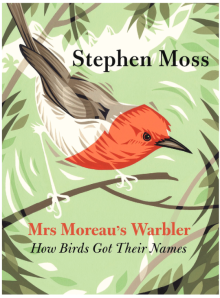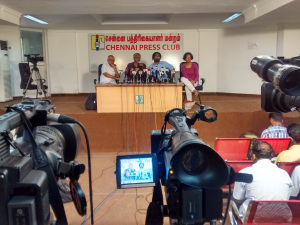Book Review – Mrs Moreau’s Warbler: How Birds Got Their Name
Posted: May 10, 2019 Filed under: Birding | Tags: Birding, history, Ornithology Leave a commentFirst published in Indian Birds: Journal of South Asian Ornithology.

The renowned British natural history writer and television producer, Stephen Moss, takes readers through, what can most succinctly be described as, a history of humanity’s interactions with avifauna. The intriguing title of the book itself deserves note, but we’ll come to that a little later. Right from the days of onomatopoeic names, names based on colour and other prominent physical features, to the colonial-era race for eponymous names, to the current debates on fairer, more modern and international naming conventions, Moss leads readers through a great sweep of time and straddles the history of science, natural history, and even linguistics. While this is the broad scope of the book, there are absorbing asides that will interest not only the ornithologist or the seasoned birder, but also the uninitiated.
Research as if People Matter
Posted: October 8, 2016 Filed under: Economic and Political Weekly | Tags: Food Security, India, National Food Security Act, NFSA, Public Distribution System, Research Leave a commentFirst published in the Economic & Political Weekly
Since the implementation of reforms enacted by the National Food Security Act 2013, the public distribution system provides food security to a larger number of people than before, and has less leakages overall in six of the poorer states of India. The methods and results of a people-centred six-state survey are presented in brief.
“First of all, thank you everybody for the hard work and goodwill,” economist Jean Drèze said with a playful smile. The room full of student volunteers, who joined the National Food Security Act (NFSA) Survey 2016 (henceforth the survey) for nothing less than “Hard Work, No Pay,” chuckled and laughed. Drèze continued, “We are very impressed with all the teams … I think the survey was really a success!” Drèze had just commenced the debriefing session that was held in Ranchi,1 marking the end of the survey. Drèze, with fellow economist Reetika Khera, initiated the survey to understand the progress in implementation of reforms to the public distribution system (PDS) after the enactment of the NFSA 2013.
Truth to Power
Posted: March 12, 2016 Filed under: Economic and Political Weekly | Tags: Catholic Church, Film, Hollywood, Movies, Sexual Violence, Spotlight Leave a commentFirst published in the Economic & Political Weekly.
By being focused and understated, the award-winning 2015 Hollywood film, Spotlight, exposes more than the sexual misdoings of priests of the Catholic Church in Boston, United States.

Spotlight film poster. Source: Wikipedia
Spotlight, the much-touted Hollywood crime drama film made last year, tells the compelling story of a team of journalists from the Boston Globe who investigated cases of child sexual abuse by Catholic priests in Boston, Massachusetts. Their investigative stories—the first of which was published in January 2002—found that the “practice” of child abuse by priests was not only widespread, but had been going on for decades, with the higher clergy actively “covering up” cases of child sexual abuse through out-of-court, off-the-record settlements. Their investigative stories led many more victims of child abuse to come forward in the United States and the world over. The Catholic church—indeed the Pope himself—has since had to acknowledge that child sexual abuse is a serious concern.
Fact-Finding Committee on Lay Offs at Tata Consultancy Services Releases Report
Posted: February 11, 2015 Filed under: Uncategorized Leave a commentKAFILA - COLLECTIVE EXPLORATIONS SINCE 2006
The following is the text of the report released by the Fact Finding Committee that investigated the issue of lay-offs at the Tata Consultancy Services. The committee, which released its report on 6 February in Chennai, consisted of the following members:
 Fact finding committee press conf , Chennai
Fact finding committee press conf , Chennai
Mr. BRP. Bhaskar, Senior Journalist and Human Rights Activist, Thiruvananthapuram;
Dr. M.Vijayabaskar, Assistant Professor, MIDS, Chennai;
Adv. Bobby Kunhu, Legal Expert, Salem;
Ms. Chandrika Radhakrishnan, Software Professional and Labour Rights Activist, Chennai
View original post 6,304 more words
Dalit Students and Journalists – from Classroom to Newsroom: Shivnarayan Rajpurohit
Posted: May 15, 2014 Filed under: Uncategorized Leave a commentKAFILA - COLLECTIVE EXPLORATIONS SINCE 2006
The conscious or unconscious exclusion of Dalits (SC/ST) from the Indian mediascape has given way to a lopsided public sphere which hardly manages to generate comprehensive debates. Corporate interests have aggravated this malaise, given the indifference of the corporate sector towards fomenting a diverse media, cutting across caste, religious and class lines. The following paper looks at the absence of Dalit journalists and students from English press and journalism schools. The primary conclusion of my research is that English-language media as an institution has been undemocratic because it draws its workforce from a homogenous set of people, overlooking the urgent need for diversity. In that sense it is hostile to opposing viewpoints and diversity of arguments. The paper is primarily divided into five parts: counting Dalit journalists, reason for exclusion, classroom to newsroom, need for Dalits in media and Blacks in USA.
View original post 3,192 more words
Behind the Facades of Sandstone
Posted: April 24, 2014 Filed under: Uncategorized | Tags: India, Labour Law, Migrant Workers, Mine Labour Protection Campaign, Miners, Mining, MLPC, Occupational Hazards, Rajasthan, Sandstone, Silicosis Leave a comment
A film on sandstone miners and silicosis.
More than 90% of the country’s (India’s) workforce belongs to the unorganised sector, yet not a single of the labour laws that protect the rights of the worker is applied to them. Unfortunately a large section of these workers without rights are engaged in highly hazardous work, which leads to premature death. Sandstone mining in Western Rajasthan is one such occupation.
Not only is the process of mining accident prone, it also raises a lot of dust which contains a high quantity of silica. Inhaling this dust over a period of time causes silicosis, which attacks the lungs leading to a slow painful death.
The Mine Labour Protection Campaign (MLPC), an NGO is campaigning for over a year to improve the conditions of the mine-workers and get them their legal dues.
The film is an attempt to support their work and the cause of the sandstone workers.
Directed and Photographed by Rajendra Shaw.
Narration and Script by Alina Sen.
Produced by Centre for Development Communication, Hyderabad for Mine Labour Protection Campaign (MLPC) with the support of Oxfam, India in 1995.
The Puzzle That is India-UAE Trade
Posted: January 11, 2014 Filed under: Economic and Political Weekly | Tags: Diamond, Gold, India, International Trade, Jewellery, reexport, reimport, round-tripping, Trade, UAE, United Arab Emirates Leave a commentPubllished in the Economic and Political Weekly
How is it that the United Arab Emirates has become India’s largest trading partner in recent years, overtaking the United States, European Union and China? An unusual pattern of two-way flows in gold, diamonds and jewellery seems to underlie the boom in bilateral trade. There is reason to suspect that some of this trade involves round tripping of merchandise and to that extent the volume of India-UAE trade may be artificially inflated.
Full article available here.
Employment Trends in India: An Overview of NSSO’s 68th Round
Posted: October 20, 2013 Filed under: Economic and Political Weekly | Tags: 68th Round, Economic and Political Weekly, employment, Employment and Unemplo, National Sample Survey Office, NSSO, Unemployment Survey Leave a commentFirst published in the Economic and Political Weekly
The findings of the Employment and Unemployment Survey 2011-12 (68th round) reveal that over nine million persons found employment between 2009-10 and 2011-12. This was characterised by some sections of the media as a “rebound” from the stagnancy between 2004-05 and 2009-10. However, our analysis shows that the average growth in employment between 2004-05 and 2011-12 remains low at 2.5 million per year. The findings also reveal that a growing proportion of the workforce is moving to non-farm activities, and a falling proportion is engaged on a casual wage.
Bajaj Auto Workers’ Agitation: Withdrawal and Triumph
Posted: September 17, 2013 Filed under: Automobile Industry, Economic and Political Weekly, Factory Workers, Strikes, Workers Struggles | Tags: automobile companies, Bajaj Auto, contract workers, Dilip Pawar, employee stock ownership, employee stock ownership plan, ESOP, Labour Rights, labour unions, Labour Unrest, New Trade Union Initiative, NTUI, pulsar, pune plant, Rajiv Bajaj, Vishwa Kalyan Kamgar Sanghatana, VKKS, Workers Strike Leave a commentFirst published in the Economic and Political Weekly
Workers at the Bajaj Auto’s Chakan unit in Pune stopped work for 50 days before unconditionally withdrawing the agitation on 13 August. The union made a controversial demand – cheap equity shares for its members. This article looks at this demand, the questions around the issue of going on strike (in the current economic atmosphere), the ability to sustain it and the lack of adequate state intervention.
Abhishek Shaw (abhishek@epw.in), Lina Mathias (lina@epw.in)
When 950 workers at the Chakan (Pune) plant of Bajaj Auto struck work on 25 June, among their demands for improved wages and work conditions was one that generated much controversy – the union asked for equity shares, or what is called employee stock ownership plan (ESOP), at Re 1 a share. While a number of information technology (IT) companies and a few in other fields are no strangers to ESOPs in India, this was the first time that workers from the assembly and production floor made the demand.
The demand for ESOP was dismissed in no uncertain terms. “No one, not even the chairman, has got free shares in the last 50 years, and we are not about to start now,” Rajiv Bajaj, managing director (MD) of Bajaj Auto, told the media. He added for good measure that if the workers’ demand is like that of a wayward child, the company, as a parent, had to be “fair but firm”. In another media interview, he said, “This is a public limited company, not a kirana (grocery) shop that I can handle (company) shares like that” (Gupta and Baggonkar 2013).
Bajaj also made it clear that his company did not believe in “buying the loyalty of people by throwing them shares”. ESOPs are okay for the IT industry or where capital is an issue, and even the automobile companies that issue shares do so only to the top management in their research and development (R&D) division and not to workers, he said.
Bajaj’s almost indignant response to the demand and the union’s justification for making it shows the chasm between how managements view workers’ role and how the latter see it. Read on…
A Nuanced History of Madras’ Working Class
Posted: August 12, 2013 Filed under: Economic and Political Weekly | Tags: Chennai, class consciousness, Ford, history, Hyundai, indian national congress, labour issues, labour unions, Madras, Nokia Siemens Networks, politics, Sanmina, The Making of the Madras Working Class, tnlabour.in Leave a commentFirst published in the Economic and Political Weekly.
The Making of the Madras Working Class by Dilip Veeraraghavan (New Delhi: Left Word ), 2013; pp 358, Rs 750.
Abhishek Shaw (abhishek@epw.in). Chandrika Radhakrishnan (vchandrikar@gmail.com) is an independent researcher and editor of Thozhilalar Koodam (Workers’ Space, www.tnlabour.in), a blog dedicated to reporting and documenting labour issues.
The little-known history of the first organised labour unions of India, formed between 1918 and 1939, and the role they played in the formation of a working-class consciousness and the struggle for Independence are vividly described in The Making of the Madras Working Class by Dilip Veeraraghavan. This book was first written as a dissertation titled “The Rise and Growth of the Labour Movement in the City of Madras and Its Environs, 1918-1939” by Veeraraghavan, who submitted it to the Indian Institute of Technology (IIT), Madras in 1987.
Published posthumously (in 2009), it is a meticulous historical account of the period and is an inspiration to students of history, as well as visually disabled students.
The book takes us back to a period in India’s history which has largely been associated with the Indian National Congress and the struggle for freedom. Veeraraghavan, however, narrates a detailed and nuanced history of the working people of Madras, with insights into the processes of negotiations between workers, labour unions, nationalist leaders, factory owners and the colonial state. The accounts in the book are relevant to the workers’ movements even today. Read on here…



